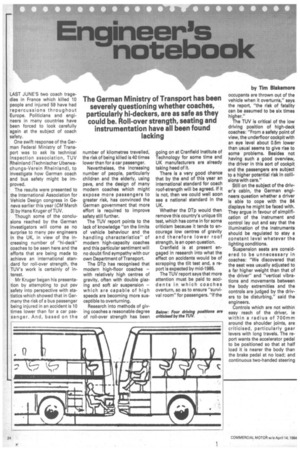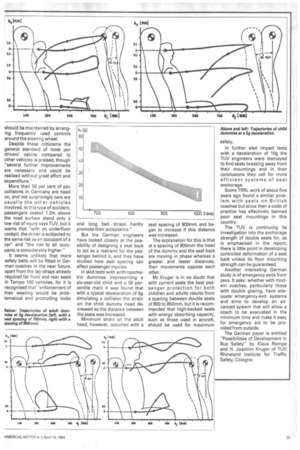by Tim Blakemore
Page 26

Page 27

If you've noticed an error in this article please click here to report it so we can fix it.
The German Ministry of Transport has been severely questioning whether coaches, particularly hi-deckers, are as safe as they could be. Roll-over strength, seating and instrumentation have all been found lacking
LAST JUNE'S two coach tragedies in France which killed 10 people and injured 59 have had repercussions throughout Europe. Politicians and engineers in many countries have been forced to look carefully again at the subject of coach safety.
One swift response of the German Federal Ministry of Transport was to ask its technical inspection association, TUV Rheinland (Technischer Uberwachungs-Verein Rheinland), to investigate how German coach and bus safety might be improved.
The results were presented to the International Association for Vehicle Design congress in Geneva earlier this year (CM March 3) by Hans Kruger of TUV.
Though some of the conclusions reached by the German investigators will come as no surprise to many psv engineers in the UK, in view of the increasing number of "hi-deck" coaches to be seen here and the efforts that are being made to achieve an international standard for roll-over strength, the TUV's work is certainly of interest.
Mr Kruger began his presentation by attempting to put psv safety into perspective with statistics which showed that in Germany the risk of a bus passenger being injured in an accident is 10 times lower than for a car passenger. And, based on the number of kilometres travelled, the risk of being killed is 40 times lower than for a car passenger.
Nevertheless, the increasing number of people, particularly children and the elderly, using pays, and the design of many modern coaches which might expose more passengers to greater risk, has convinced the German government that more effort is required to improve safety still further.
The TUV report points to the lack of knowledge "on the limits of vehicle behaviour and the handling characteristics" of modern high-capacity coaches and this particular sentiment will no doubt find sympathy with our own Department of Transport.
The DTp has recognised that modern high-floor coaches — with relatively high centres of gravity, often with double glazing and soft air suspension — which are capable of high speeds are becoming more susceptible to overturning.
Research into methods of giving coaches a reasonable degree of roll-over strength has been going on at Cranfield Institute of Technology for some time and UK manufacturers are already taking heed of it.
There is a very good chance that by the and of this year an international standard for coach roof-strength will be agreed. If it is not, then we could well soon see a national standard in the UK.
Whether the DTp would then remove this country's unique tilt test, which has come in for some criticism because it tends to encourage low centres of gravity and therefore lower roof strength, is an open question.
Cranfield is at present engaged in research into what the effect on accidents would be of scrapping the tilt test and, a report is expected by mid-1985.
The TUV report says that more attention must be paid to accidents in which coaches overturn, so as to ensure "survival room" for passengers. "If the occupants are thrown out of the vehicle when it overturns," says the report, "the risk of fatality can be assumed to be six times higher."
The TUV is critical of the low driving position of high-deck coaches: "From a safety point of view, the underfloor cockpit with an eye level about 0.5m lower than usual seems to give rise to some problems. Besides not having such a good overview, the driver in this sort of cockpit and the passengers are subject to a higher potential risk in collisions with cars," Still on the subject of the driver's cabin, the German engineers question whether a driver is able to cope with the 84 displays he might be faced with. They argue in favour of simplification of the instrument and control lay out and say that the illumination of the instruments should be regulated to stay a constant level whatever the lighting conditions.
Suspension seats are considered to be unnecessary in coaches: "We discovered that the seat was usually adjusted to a far higher weight than that of the driver" and "vertical vibrations and movements between the body extremities and the controls are judged by the drivers to be disturbing," said the engineers.
Controls which are not within easy reach of the driver, ie within a radius of 7 0 Omm around the shoulder joints, are criticised, particularly gear levers with long travels. The report wants the accelerator pedal to be positioned so that at half load it is nearer the body than the brake pedal at no load; and continuous two-handed steering should be maintained by arranging frequently used controls around the steering wheel.
Despite these criticisms the general standard of most psv drivers' cabins compared to other vehicles is praised, though "several further improvements are necessary and could be realised without great effort and expenditure."
More than 50 per cent of psv collisions in Germany are head on, and not surprisingly cars are usually the other vehicles involved. In this type of accident, passengers seated 1.2m above the road surface stand only a low risk of injury says TUV, but it warns that "with an underfloor cockpit, the driver is subjected to the same risk as an occupant of a car" and "the risk to all occupants is considerably higher."
It seems unlikely that more safety belts will be fitted in German coaches in the near future, apart from the lap straps already required for front and rear seats in Tempo 100 vehicles, for it is recognised that "enforcement of their wearing would be problematical and protruding locks and long belt straps hardly promote their acceptance."
But the German engineers have looked closely at the possibility of designing a seat back to act as a restraint for the passenger behind it, and they have studied how seat spacing can affect passenger injuries.
In skid tests with anthropometric dummies (representing a six-year-old child and a 50 percentile man) it was found that with a typical deceleration of 5g simulating a collision the strain on the child dummy head decreased as the distance between the seats was increased.
Minimum strain on the adult head, however, occurred with a seat spacing of 800mm and began to increase if this distance was increased.
The explanation for this is that at a spacing of 800mm the head of the dummy and the seat back are moving in phase whereas a greater and lesser distances, their movements oppose each other.
Mr Kruger is in no doubt that with current seats the best passenger protection for both children and adults results from a spacing between double seats of 800 to 850mm, but it is recommended that high-backed seats with energy absorbing capacity, such as those used in aircraft, should be used for maximum safety.
In further sled impact tests with a deceleration of log the TUV engineers were dismayed to find seats breaking away from their mountings and in their conclusions they call for more efficient systems of seat anchorage.
Some TRRL work of about five years ago found a similar problem with seats on British coaches but since then a code of practice has effectively banned poor seat mountings in this country.
The TUV is continuing its investigation into the anchorage strength of double seats for, as is emphasised in the report, there is little point in developing controlled deformation of a seat back unless its floor mounting strength can be guaranteed.
Another interesting German study is of emergency exits from psvs. It asks: whether with modern coaches, particularly those with double glazing, have adequate emergency-exit systems and aims to develop an advanced system that will allow a coach to be evacuated in the minimum time and make it easy for emergency aid to be provided from outside.
The German paper is entitled "Possibilities of Development in Bus Safety" by Klaus Rompe and H. Joachim Kruger of TUV Rhineland Institute for Traffic Safety, Cologne.




























































































